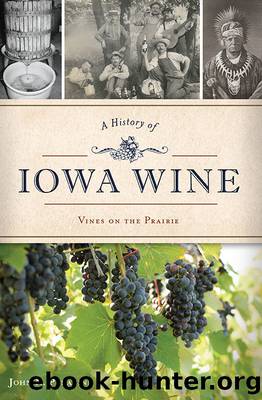A History of Iowa Wine by John N. Peragine

Author:John N. Peragine
Language: eng
Format: epub
ISBN: 9781439666685
Publisher: Arcadia Publishing Inc.
Published: 2019-08-15T00:00:00+00:00
Amana schoolhouse can be seen on the left of the photo. Grapes can be seen growing on the trellises on the side of the building, which was common in the Amana colonies. Amana Heritage Society.
Winemaking was a part of culture in Germany and had a long history in Europe, so when the Inspirationists finally came to America, they brought these traditions and knowledge with them. Even though they were very strict about certain societal norms, they never prohibited the consumption of alcohol.
In 1843, the Inspirationists came to America and settled on a large tract of land in Buffalo, New York, that became known as Eben-Ezer. This five-thousand-acre tract of land included six communal living communities that worked for the common good of the community without pay. In return, residents were given food, housing, clothing and anything they needed by the society that oversaw them.
The area where they settled is a popular area for vineyards today, located near the Great Lakes. However, the settlers, while planting a number of orchards, did not plant large vineyards. It was not until the Inspirationists settled in Amana, Iowa, in the 1850s that they began the practice of planting grapevines that trellised up the sides of their homes.
WINE TICKETS
In Amana, the production of wine was substantial, although in the early years it was considered communal and placed in the societyâs wine cellars. Everything produced in the community was for the entire society to use. Wine was no exception, but it was regulated a bit. Each person was given an allotment of wine per year. This allotment varied a bit from year to year. On average, an adult male was given twelve gallons and a woman received six gallons. In some years, this number reached twenty gallons per man. On average, the villages produced four thousand to eight thousand gallons of wine annually.
The allotment came in the form of a wine ticket. When a member came for wine, the ticket was punched and a recording of the distribution was made in a record book. Like in any community, not everyone wanted to drink, so members could give their tickets to relatives or friends who did drink. In addition to the society membersâ allotment, extra wine was given to farm crews in the field, including boys as young as fourteen.
Download
This site does not store any files on its server. We only index and link to content provided by other sites. Please contact the content providers to delete copyright contents if any and email us, we'll remove relevant links or contents immediately.
| Air Travel | Bed & Breakfasts |
| Cruises | Dining |
| Hotels & Inns | Parks & Campgrounds |
| Railroad Travel | Road Travel |
Good by S. Walden(3516)
A Short History of Nearly Everything by Bryson Bill(2659)
Claridge's: The Cookbook by Nail Martyn & Erickson Meredith(2379)
Hidden Valley Road by Robert Kolker(2262)
On Trails by Robert Moor(1869)
The Art of Flight by unknow(1839)
Rick Steves London 2018 by Rick Steves & Gene Openshaw(1838)
Deep South by Paul Theroux(1798)
KITCHEN CONFIDENTIAL Adventures in the Culinary Underbelly by Anthony Bourdain(1774)
Blue Highways by William Least Heat-Moon(1740)
Trans-Siberian Railway by Lonely Planet(1725)
1,000 Places to See in the United States and Canada Before You Die (1,000 Places to See in the United States & Canada Before You) by Patricia Schultz(1622)
Long Bright River by Liz Moore(1568)
Ticket to Ride by Tom Chesshyre(1566)
Flight by Elephant(1509)
The Great Railway Bazaar: By Train Through Asia by Paul Theroux(1486)
BBQ Joints by David Gelin(1443)
The Old Patagonian Express: By Train Through the Americas by Paul Theroux(1373)
Practice Makes Perfect by Gilda Nissenberg(1350)
